Getting a great tone on electric guitar involves more than just hitting the right notes; it’s about crafting a sound that resonates with your musical vision, and here at guitarplayers.net, we understand that. Fine-tuning your guitar tone is like finding the perfect voice for your instrument, significantly impacting your overall sound and musical expression. Whether you’re tweaking your equipment or exploring new playing techniques, there are many ways to enhance your sound.
1. What Role Does The Guitar Pick Play In Shaping Electric Guitar Tone?
Your guitar pick dramatically influences your tone. Thin picks are excellent for soft, acoustic sounds, while metal picks provide a bright, harmonic-rich sound ideal for rock. Experiment with different picks to discover what suits your playing style.
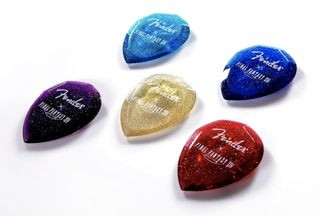 Fender Guitar Pick
Fender Guitar Pick
The choice of a guitar pick extends beyond mere practicality; it’s a crucial element in shaping the sonic landscape of your music. A thinner pick, often made from materials like plastic or Tortex, offers flexibility and a softer attack, making it ideal for strumming gentle acoustic passages or creating laid-back rhythms. The give in these picks allows for a smoother interaction with the strings, producing a warmer, more mellow tone that sits comfortably in the mix of a soft rock ballad.
Conversely, a metal pick delivers a sharp, aggressive attack that’s perfect for genres demanding bite and clarity. The rigid nature of metal against the strings generates a bright, articulate sound with pronounced harmonics, reminiscent of iconic tones from bands like Queen or ZZ Top. This type of pick is particularly effective for lead work, where precision and definition are paramount.
Ultimately, the ideal pick is one that aligns with your personal playing style and sonic preferences. Experimentation is key to unlocking the full potential of your instrument and discovering the nuances that different picks can bring to your tone. At guitarplayers.net, we encourage you to explore the vast array of options available and find the perfect match for your musical expression.
2. How Do String Gauges Impact Electric Guitar Tone And Playability?
String gauge significantly affects tone and playability. Heavier strings can offer a richer tone but require more finger strength, while lighter strings are easier to play but may sound thinner. Tailor your string gauge to your comfort and desired sound.
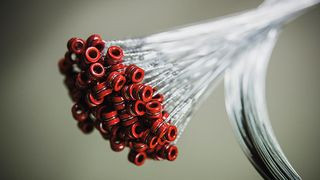 Electric Guitar Strings
Electric Guitar Strings
The relationship between string gauge, tone, and playability is a nuanced one, with each factor influencing the others in subtle yet significant ways. Heavier strings, typically those with a larger diameter, possess greater mass, resulting in a fuller, more resonant tone with enhanced sustain and projection. This added mass also contributes to increased string tension, which can improve clarity and definition, particularly in lower registers. However, the trade-off is that heavier strings require more finger strength and can be more challenging to bend, making them less forgiving for beginners or players with smaller hands.
Lighter strings, on the other hand, offer greater ease of playability due to their reduced tension and smaller diameter. These strings are easier to fret and bend, making them ideal for players who prioritize speed and agility. However, the lighter gauge can result in a thinner, less robust tone with reduced sustain and projection. This can be particularly noticeable in high-gain situations, where the lack of body can lead to a brittle or harsh sound.
Ultimately, the optimal string gauge is a matter of personal preference and playing style. Factors such as the type of guitar, the genre of music, and the player’s physical capabilities all play a role in determining the ideal gauge. Experimentation is key to finding the perfect balance between tone, playability, and comfort. At guitarplayers.net, we offer a wealth of resources and guidance to help you navigate the complexities of string gauge and unlock the full potential of your instrument.
3. What Role Do String Materials And Construction Play In Electric Guitar Tone?
String material and construction are crucial for tone. Different alloys and winding methods (flatwound, roundwound, half-round) produce unique sounds. Experiment to find the right strings for your musical style.
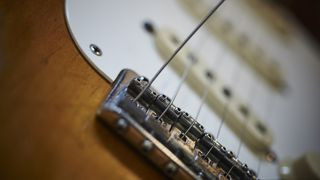 Closeup of electric guitar strings
Closeup of electric guitar strings
String materials and construction play a vital role in shaping the tonal characteristics of an electric guitar. Different alloys and winding methods offer distinct sonic qualities, catering to various musical styles and preferences. Exploring these options can significantly enhance your guitar’s sound.
- Alloys:
- Nickel-plated steel: These strings are popular for their balanced tone, providing warmth and clarity. They are versatile and suitable for various genres, including rock, blues, and pop.
- Stainless steel: Known for their brightness and sustain, stainless steel strings are ideal for genres that require a crisp, articulate sound, such as metal and progressive rock.
- Pure nickel: Offering a vintage tone with a warm, mellow character, pure nickel strings are favored by jazz and blues players.
- Winding Methods:
- Roundwound: The most common type, roundwound strings have a distinct texture that produces a bright, defined tone with good sustain. They are versatile and suitable for various playing styles.
- Flatwound: These strings have a smooth surface, resulting in a warm, mellow tone with reduced finger noise. Flatwound strings are often preferred by jazz guitarists for their smooth sound and comfortable feel.
- Half-round: Combining characteristics of both roundwound and flatwound strings, half-rounds offer a balance of warmth and brightness with a smoother feel than roundwounds.
Experimenting with different string materials and winding methods can help you discover the perfect strings that complement your playing style and musical preferences. Whether you’re seeking a vintage tone, a bright sound, or a smooth feel, understanding these factors will guide you in achieving your desired guitar tone.
4. How Can Managing Bass Frequencies Improve Your Electric Guitar Tone In A Band Setting?
Reduce bass frequencies on your guitar to avoid clashing with the bass guitar. Focusing on the midrange allows your guitar to cut through the mix effectively and creates a clearer overall sound for the band.
 Mastodon Band
Mastodon Band
In a band setting, the key to achieving a cohesive and impactful sound lies in the careful management of each instrument’s frequency range. While it may be tempting to boost the bass frequencies on your guitar in an attempt to create a fuller, more powerful tone, this can often result in a muddy and indistinct mix, particularly when a bass guitar is already occupying the low-end spectrum.
Instead, consider carving out space for the bass guitar by reducing the bass frequencies on your guitar. This allows the bass to shine through with clarity and definition, providing a solid foundation for the rest of the band. By focusing on the midrange frequencies, your guitar can cut through the mix with ease, delivering a clear and articulate sound that complements the other instruments.
This approach not only improves the overall clarity of the band’s sound but also enhances each instrument’s individual presence. By avoiding unnecessary competition in the low-end, the bass guitar can establish its sonic territory, while the guitar can occupy its own distinct space in the midrange. The result is a balanced and harmonious mix where each instrument contributes to the overall sonic tapestry without stepping on each other’s toes.
Ultimately, managing bass frequencies in a band setting is about collaboration and cooperation. By understanding how each instrument interacts with the others, you can create a sound that is both powerful and well-defined. At guitarplayers.net, we encourage you to experiment with different EQ settings and frequency ranges to find the perfect balance for your band’s unique sound.
5. How Does Reducing Saturation At High Volumes Enhance Electric Guitar Tone?
Decrease saturation as volume increases. High volume amps, especially tube amps, naturally produce distortion. Reducing pedal distortion prevents a muddy sound and maintains clarity at louder volumes.
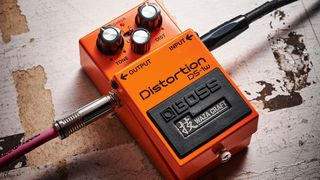 Boss DS-1W Distortion Pedal
Boss DS-1W Distortion Pedal
The interplay between saturation and volume is a delicate dance that requires careful attention to detail. What sounds pleasing at low volumes can quickly become overwhelming and muddy when the volume is cranked up. This is especially true when using distortion pedals in conjunction with high-volume amplifiers, particularly tube amps, which naturally produce their own form of distortion as they reach their sweet spot.
When the amplifier is already contributing a significant amount of distortion, adding even more saturation from a pedal can result in a signal that is overly compressed and lacking in clarity. The individual notes become blurred together, and the overall sound loses its definition and punch.
Therefore, it is often beneficial to reduce the amount of saturation from your pedals as the volume increases. This allows the natural distortion characteristics of the amplifier to shine through while maintaining a degree of clarity and articulation. By carefully balancing the gain levels of both the pedal and the amplifier, you can achieve a tone that is both powerful and well-defined.
This approach requires a degree of experimentation and adjustment, as the optimal settings will vary depending on the specific gear being used and the desired tonal outcome. However, the general principle remains the same: less is often more when it comes to saturation at high volumes. At guitarplayers.net, we encourage you to explore the nuances of gain staging and find the sweet spot that allows your guitar to sing with clarity and authority.
6. How Can An EQ Notch Filter Eliminate Feedback In Electric Guitar Setups?
Use an EQ pedal with a notch filter to target and eliminate feedback frequencies. Precise cuts in the problematic frequency range can prevent the shrill sounds, especially at high volumes.
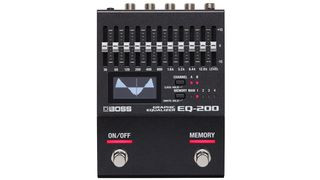 Boss EQ-200 EQ pedal
Boss EQ-200 EQ pedal
Feedback, that piercing, high-pitched squeal that can plague guitarists who play at high volumes or with high gain, can be a frustrating and disruptive issue. Fortunately, an EQ notch filter can be a powerful tool in combating this unwanted phenomenon.
An EQ notch filter is a specialized type of equalizer that allows you to make precise cuts in a narrow frequency range. By identifying the specific frequency at which feedback is occurring, you can use the notch filter to attenuate that frequency, effectively eliminating the feedback without significantly impacting the overall tone of your guitar.
To use an EQ notch filter effectively, it’s essential to first identify the frequency at which the feedback is occurring. This can be done by carefully listening to the feedback and using your ears to determine the pitch of the squeal. Alternatively, you can use a spectrum analyzer or a real-time analyzer app to visually identify the offending frequency.
Once you’ve identified the feedback frequency, set the notch filter to that frequency and adjust the depth of the cut until the feedback is eliminated. Be careful not to cut too deeply, as this can negatively impact the overall tone of your guitar. A subtle cut is often all that’s needed to effectively eliminate feedback.
It’s also important to note that feedback frequencies can vary depending on the room you’re playing in and the position of your guitar and amplifier. Therefore, it’s a good idea to have an EQ pedal with a notch filter readily available and be prepared to make adjustments as needed.
7. What Is Top-Wrapping A Tune-O-Matic Bridge And How Does It Affect Tone?
Top-wrapping involves stringing a Les Paul so the strings wrap over the tailpiece, increasing resonance. This method can make the strings feel slinkier and enhance the guitar’s overall vibration.
Top-wrapping a Tune-O-Matic bridge is a technique used by many guitarists, particularly those who play Les Pauls, to alter the feel and resonance of their instrument. This involves stringing the guitar in a way that the strings wrap over the top of the tailpiece, rather than being directly connected to it.
The primary purpose of top-wrapping is to reduce the string tension and make the strings feel slinkier, which can make bending and vibrato techniques easier to execute. This is achieved by increasing the break angle of the strings over the bridge, which in turn reduces the overall tension on the strings.
In addition to the improved playability, top-wrapping is also believed to enhance the guitar’s overall resonance and sustain. By reducing the tension on the strings, the guitar’s body is allowed to vibrate more freely, resulting in a richer, more resonant tone with increased sustain.
While the effects of top-wrapping can be subtle, many guitarists swear by this technique and claim that it makes a noticeable difference in the feel and sound of their instrument. Whether or not it’s right for you is a matter of personal preference, but it’s certainly worth experimenting with to see if it improves your playing experience.
8. What Is A Treble Bleed Mod On A Volume Control And How Does It Preserve High Frequencies?
A treble bleed mod adds a capacitor (or resistor and capacitor) to the volume pot, preserving high frequencies as you lower the volume. This prevents the tone from becoming muddy at lower settings.
A treble bleed mod is a modification made to a guitar’s volume control that helps to preserve high frequencies as the volume is reduced. This is a common issue with standard guitar volume controls, which can cause a loss of treble and a muddier tone as the volume is turned down.
The treble bleed mod works by adding a capacitor, or a resistor and capacitor in parallel, to the volume potentiometer (pot). This allows high frequencies to bypass the pot as the volume is reduced, preventing them from being filtered out.
The capacitor value is typically in the range of 1000 picofarads (pF) to 1500 pF, while the resistor value is typically in the range of 100 kilohms (kΩ) to 150 kΩ. The specific values used will depend on the player’s preference and the guitar’s specific characteristics.
The result of the treble bleed mod is a more consistent tone across the entire volume range. The high frequencies remain present even at low volumes, preventing the tone from becoming muddy or dull. This can be particularly useful for players who use their volume control to clean up their tone or for those who prefer to play with a lower volume setting.
The treble bleed mod is a relatively simple and inexpensive modification that can make a significant improvement to a guitar’s tone. It is a popular choice among guitarists who want to preserve their high frequencies and maintain a consistent tone across the entire volume range.
9. How Can Assigning A Tone Pot To The Bridge Pickup Improve A Stratocaster’s Tone?
Wiring a tone pot to the bridge pickup on a Stratocaster allows you to tame its often harsh tone. This modification provides greater control over the high frequencies, resulting in a more balanced sound.
 Fender American Vintage II 1961 Stratocaster
Fender American Vintage II 1961 Stratocaster
The Stratocaster, a cornerstone of electric guitar history, is renowned for its versatility and iconic tone. However, one common complaint among Strat players is the sometimes shrill or harsh tone of the bridge pickup. This can be particularly noticeable when playing with high gain or in brighter-sounding rooms.
One simple yet effective modification to address this issue is to assign a tone pot to the bridge pickup. Traditionally, Stratocasters have one tone pot for the neck pickup and another for the middle pickup, leaving the bridge pickup without any tone control. By wiring one of the tone pots to the bridge pickup, you gain the ability to tame its high frequencies and achieve a more balanced and usable tone.
This modification is relatively easy to perform and requires only basic soldering skills. The most common approach is to disconnect the tone pot from the middle pickup and wire it to the bridge pickup instead. This allows you to roll off the high frequencies of the bridge pickup, making it sound smoother and less harsh.
The result is a Stratocaster with a more versatile and balanced tone. The bridge pickup can now be used in a wider range of musical styles and situations, and you have greater control over your overall sound.
10. Does Raising The Action On An Electric Guitar Improve Tone?
Raising the action can improve tone by reducing string buzz. A slightly higher action allows the strings to vibrate more freely, resulting in a cleaner, fuller sound, especially beneficial if you are not focused on shredding.
The height of the strings above the fretboard, known as the action, can have a significant impact on the tone and playability of an electric guitar. While a low action is often preferred by shredders and players who prioritize speed and ease of play, raising the action slightly can offer several tonal benefits.
One of the primary advantages of raising the action is the reduction of string buzz. When the strings are too close to the frets, they can vibrate against them, creating an unwanted buzzing sound that can detract from the overall tone. By raising the action, you provide more clearance between the strings and the frets, allowing the strings to vibrate more freely without buzzing.
In addition to reducing string buzz, raising the action can also improve the sustain and clarity of the guitar’s tone. When the strings have more room to vibrate, they can sustain longer and produce a fuller, more resonant sound. This can be particularly noticeable on guitars with thinner bodies or weaker pickups.
Of course, raising the action too high can make the guitar more difficult to play, especially for players with smaller hands or those who prefer a lighter touch. Therefore, it’s important to find a balance between tone and playability that works for you. Experiment with different action heights until you find the sweet spot that provides the best combination of tone, sustain, and comfort.
11. How Does The Order Of Guitar Pedals Affect The Overall Tone?
The order of your guitar pedals significantly affects tone. Wah pedals should come before distortion, with delays and reverbs in the effects loop for optimal sound quality. Compressors can be placed at the beginning or end of the chain depending on the desired effect.
The order in which you arrange your guitar pedals can have a profound impact on your overall tone, influencing everything from the clarity and dynamics of your sound to the way your effects interact with one another. While there are no hard and fast rules, there are some general guidelines that can help you achieve the best possible results.
- Wah Pedals: Wah pedals are typically placed first in the signal chain, before any distortion or overdrive pedals. This allows the wah to shape the clean signal before it is processed by any gain-based effects, resulting in a more pronounced and expressive wah sound.
- Distortion and Overdrive Pedals: These pedals are typically placed after wah pedals and before any modulation or time-based effects. This allows the distortion to amplify the signal and create a more aggressive and saturated tone.
- Modulation Effects: Modulation effects, such as chorus, flanger, and phaser, are typically placed after distortion and overdrive pedals and before delay and reverb. This allows the modulation to add depth and texture to the distorted signal.
- Delay and Reverb Pedals: Delay and reverb pedals are typically placed last in the signal chain, either in the effects loop of your amplifier or after all other pedals. This allows these effects to create a sense of space and ambience around the other effects, resulting in a more natural and immersive sound.
- Compressors: Compressors can be placed either at the beginning or end of the signal chain, depending on the desired effect. When placed at the beginning, a compressor can help to even out the dynamics of your playing and create a more consistent signal. When placed at the end, a compressor can help to glue all of the effects together and create a more polished and professional sound.
12. How Does Adjusting Pickup Height Improve Electric Guitar Tone?
Adjusting pickup height affects output and tone. Raising pickups increases output but can cause “wolf notes.” Finding the balance between output and tonal clarity is key to optimizing your sound.
The distance between your guitar’s pickups and the strings can have a significant impact on both the output level and the tonal characteristics of your instrument. Adjusting the pickup height is a simple yet effective way to fine-tune your sound and achieve the desired balance between power and clarity.
Raising the pickups closer to the strings will generally increase the output level, resulting in a louder and more aggressive tone. This can be particularly useful for driving your amplifier harder and achieving a more saturated and distorted sound. However, raising the pickups too close to the strings can also have negative consequences.
When the pickups are too close to the strings, the magnetic field of the pickups can interfere with the natural vibration of the strings, causing what are known as “wolf notes.” These are unpleasant, dissonant sounds that occur when the magnetic field pulls on the strings, causing them to vibrate erratically.
Therefore, it’s important to find the sweet spot where the balance of output level and tonal purity meet. Experiment with adjusting the pickup height until you find the position that provides the desired output level without causing any unwanted wolf notes or other tonal anomalies.
A good starting point is to lower the pickups until the wolf notes disappear and then gradually raise them until you achieve the desired output level. You can also use a screwdriver to adjust the height of individual pole pieces, which can further fine-tune the balance of each string.
13. How Do String Mutes Clean Up Lead Playing On Electric Guitar?
String mutes, like fretwraps, minimize unwanted string noise for cleaner lead playing. These devices dampen strings, reducing sympathetic vibrations and improving clarity.
In the pursuit of pristine lead playing, guitarists often grapple with the challenge of unwanted string noise. Open strings ringing out sympathetically, fingers accidentally brushing against adjacent strings—these sonic artifacts can muddy the waters and detract from the clarity and precision of your playing. String mutes offer a simple yet effective solution to this common problem.
String mutes, such as fretwraps, are designed to dampen the strings, minimizing unwanted vibrations and reducing string noise. These devices typically consist of a soft, absorbent material, such as felt or foam, that is wrapped around the strings behind the nut or behind the bridge.
By dampening the strings, string mutes prevent them from ringing out sympathetically, which can be particularly useful when playing complex chords or fast, intricate passages. They also help to reduce the noise of fingers sliding on the strings, resulting in a cleaner, more focused sound.
String mutes are available in a variety of shapes and sizes to accommodate different types of guitars and playing styles. Some mutes are designed to be used behind the nut, while others are designed to be used behind the bridge. Some mutes are adjustable, allowing you to fine-tune the amount of damping to suit your preferences.
Whether you’re a seasoned shredder or a beginner just starting out, string mutes can be a valuable tool in your quest for cleaner, more articulate lead playing. By minimizing unwanted string noise, they allow you to focus on your playing and achieve a more polished and professional sound.
14. How Do Buffer Pedals Help Maintain Electric Guitar Tone Over Long Cable Lengths?
Buffer pedals counteract signal degradation from long cables and pedal chains. They maintain signal strength and high-end frequencies, ensuring a clear and consistent tone.
As a guitar player, you know that your tone is everything. It’s the unique sonic signature that defines your playing style and sets you apart from the crowd. But what happens when your tone starts to degrade, becoming dull and lifeless?
One of the most common causes of tone degradation is the use of long cable lengths and long chains of effects pedals. These can cause the signal to weaken and lose its high-end frequencies, resulting in a muddy and indistinct sound.
Fortunately, there’s a simple solution to this problem: buffer pedals. Buffer pedals are designed to counteract signal degradation by maintaining signal strength and high-end frequencies. They work by converting the high-impedance signal from your guitar into a low-impedance signal, which is less susceptible to signal loss and interference.
By placing a buffer pedal at the beginning of your signal chain, you can ensure that your signal remains strong and clear, even when using long cable lengths and multiple effects pedals. This can make a significant difference in the overall quality of your tone, helping you to achieve a more vibrant and articulate sound.
If you own a lot of pedals, there’s a good chance that one of them already has an onboard buffer. However, if you’re using a super-long cable or a chain of true bypass pedals, a dedicated buffer pedal is an affordable and effective way to maintain your tone.
15. How Can A Clean Boost Pedal Enhance Electric Guitar Tone?
A clean boost pedal increases signal level without significant tonal changes. It’s perfect for solos, adding brightness, or driving a tube amp harder for more natural overdrive.
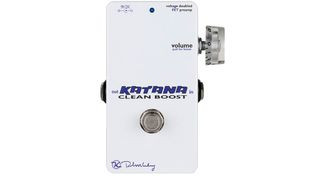 Keeley Electronics Katana Boost
Keeley Electronics Katana Boost
A clean boost pedal is a secret weapon in the arsenal of many gigging guitarists. Its primary function is to increase the signal level of your guitar without significantly altering its tonal characteristics. This can be incredibly useful in a variety of situations, from boosting your signal for solos to adding a touch of brightness to your tone.
One of the most common uses for a clean boost pedal is to increase your signal level for solos. By placing the boost pedal in your signal chain and activating it when you want to take a solo, you can ensure that your guitar cuts through the mix and stands out from the rest of the band.
Another use for a clean boost pedal is to add a touch of brightness to your tone. Some boost pedals have a built-in EQ circuit that allows you to boost certain frequencies, such as the high-end. This can be useful for adding clarity and sparkle to your tone, particularly when playing in a band setting.
Clean boost pedals can also be used to drive a tube amp harder. By boosting the signal level going into your amp, you can push the tubes into overdrive, creating a natural and organic distortion. This can be a great way to achieve a vintage-style overdrive tone without having to rely on distortion pedals.
Whether you’re looking to boost your signal for solos, add brightness to your tone, or drive your tube amp harder, a clean boost pedal is a versatile and essential tool for any guitarist.
16. How Does A Guitar Setup Improve Tone?
A professional guitar setup ensures optimal playability and tone. Adjustments to action, intonation, and neck relief can significantly enhance your guitar’s sound and feel.
Maintaining your guitar in optimal condition is essential for achieving the best possible tone and playability. A professional guitar setup involves a series of adjustments to ensure that your instrument is performing at its peak.
- Action: The action refers to the height of the strings above the fretboard. A well-adjusted action allows for comfortable playing without excessive string buzz.
- Intonation: Intonation refers to the accuracy of the pitch as you move up the fretboard. Proper intonation ensures that your guitar plays in tune across the entire neck.
- Neck Relief: Neck relief refers to the amount of curvature in the guitar’s neck. Proper neck relief allows for comfortable playing without excessive string buzz or difficulty fretting notes.
- Pickup Height: Adjusting the height of your pickups can significantly affect the tone of your guitar. Raising the pickups closer to the strings increases the output level and can add more sustain, while lowering the pickups can reduce output and create a cleaner tone.
- Hardware: Ensuring that all hardware components, such as tuners, bridge, and nut, are properly adjusted and lubricated can improve the overall stability and playability of your guitar.
By investing in a professional guitar setup, you can ensure that your instrument is performing at its best, allowing you to focus on your playing and achieve the best possible tone.
17. How Can Identifying Your Tonal Problem First Help You Improve Your Electric Guitar Tone?
Before upgrading gear, identify specific tonal issues. Optimizing existing equipment may solve the problem, saving money and unnecessary changes.
Before embarking on a quest for new gear or making drastic changes to your setup, it’s essential to take a step back and identify the specific tonal issues that you’re trying to address. This will help you avoid unnecessary expenses and ensure that you’re making changes that will actually improve your sound.
Start by asking yourself what you don’t like about your current tone. Is it too muddy? Too harsh? Lacking in sustain? Once you’ve identified the specific problem, you can begin to explore potential solutions.
In many cases, the solution may be as simple as adjusting the settings on your existing gear. Experiment with different EQ settings on your amplifier or pedals, and try adjusting the pickup height on your guitar. You may be surprised at how much of a difference these simple tweaks can make.
If you’re still not satisfied with your tone after optimizing your existing gear, then it may be time to consider upgrading. However, even when upgrading, it’s important to be specific about what you’re looking for. Do you need a new amplifier with more headroom? A new set of pickups with a different tonal character?
By taking the time to identify your tonal problem first, you can avoid making impulsive purchases and ensure that you’re making changes that will actually improve your sound.
18. How Does Using The Right-Sized Amp Affect Your Electric Guitar Tone?
Using an appropriately sized amp is crucial. Tube amps sound best when pushed to their “sweet spot,” so choose an amp that matches your typical playing volume for optimal tone.
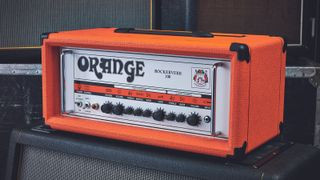 Best amps for metal: Orange Rockerverb 100
Best amps for metal: Orange Rockerverb 100
The size and wattage of your amplifier can have a significant impact on your overall tone. Tube amps, in particular, are known for sounding their best when pushed to their “sweet spot,” which is typically at a certain volume level.
If you’re playing in a small room or at low volumes, a large, high-wattage amplifier may not be the best choice. These amps often sound cold, brittle, or harsh when not turned up loud enough to reach their sweet spot.
On the other hand, if you’re playing in a large venue or with a loud band, a small, low-wattage amplifier may not have enough power to cut through the mix. These amps can sound thin, weak, or muddy when pushed too hard.
The key is to choose an amplifier that is appropriately sized for your typical playing volume and venue. For small rooms and low-volume playing, a small, low-wattage amplifier is often the best choice. For large venues and loud band settings, a larger, high-wattage amplifier may be necessary.
Ultimately, the best way to determine the right-sized amp for your needs is to experiment and try out different amplifiers in different settings. Listen carefully to the tone and volume of each amplifier, and choose the one that sounds the best and provides the most appropriate amount of power for your playing style and venue.
FAQ: Mastering Your Electric Guitar Tone
Here are some frequently asked questions to help you dial in that perfect electric guitar tone.
1. What is the first step to improving my electric guitar tone?
Start by assessing your current gear and identifying what you dislike about your tone. Then, experiment with different settings and adjustments on your guitar and amp.
2. How often should I change my electric guitar strings to maintain good tone?
Change your strings every one to three months, depending on how often you play. Fresh strings provide a brighter and more resonant tone.
3. Can the type of cable I use affect my electric guitar tone?
Yes, high-quality cables can preserve your signal and prevent tone loss, especially over longer distances.
4. What role does my amplifier play in my electric guitar tone?
Your amplifier is a crucial component. Experiment with different amps and settings to find what best suits your guitar and playing style.
5. How important are effects pedals in shaping my electric guitar tone?
Effects pedals can significantly alter your tone, adding depth, texture, and character. Experiment with different pedals and combinations to find your signature sound.
6. Should I invest in a professional setup for my electric guitar?
Yes, a professional setup can greatly improve playability and tone by ensuring proper action, intonation, and neck relief.
7. How can I reduce unwanted noise and hum from my electric guitar?
Use shielded cables, ensure proper grounding, and consider using a noise gate pedal to minimize unwanted noise.
8. What is the best way to EQ my electric guitar for different genres?
Experiment with different EQ settings to match the genre. For example, scoop the mids for metal or boost the mids for blues.
9. How does my playing technique affect my electric guitar tone?
Your technique, including pick attack, finger placement, and vibrato, significantly influences tone. Practice and refine your technique for better control and expression.
10. Where can I find more resources to learn about electric guitar tone?
Explore websites like guitarplayers.net for articles, lessons, and community forums to enhance your knowledge and skills.
Achieving a great electric guitar tone is a journey of experimentation and discovery. By understanding the various factors that influence your tone and taking the time to dial in your gear, you can unlock your instrument’s full potential and create a sound that is uniquely your own. At guitarplayers.net, we offer a wealth of resources to help you on this journey. Explore our lessons, reviews, and community forums to find the information and inspiration you need to take your playing to the next level. Don’t hesitate—visit guitarplayers.net today to explore our lessons, find your favorite sheet music, read detailed reviews, and join our vibrant community of guitar enthusiasts.
Address: 1140 Boylston Street, Boston, MA 02215, United States. Phone: +1 (617) 747-2261. Website: guitarplayers.net.
